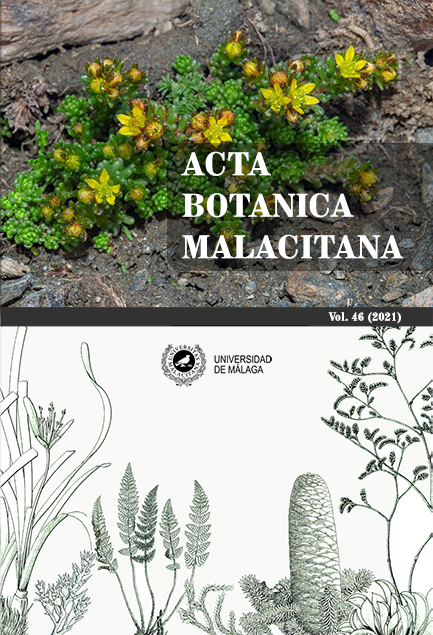Primera cita de Alternanthera philoxeroides (Mart.) Griseb. (Amaranthaceae) en el Sur de la Península Ibérica (Sevilla, España)
DOI:
https://doi.org/10.24310/abm.v46i.11448Palabras clave:
especies exóticas, corología, flora vascular, Península Ibérica, plantas acuáticas, río GuadlaquivirResumen
Se informa de la presencia de la especie exótica invasora Alternanthera philoxeroides en el río Guadalquivir, en Sevilla (España, S. de la Península Ibérica). El hallazgo corresponde a la primera cita para Andalucía y se añade a las otras dos que ya existían para la Península Ibérica.
Descargas
Métricas
Citas
Abbas, T., Tanveer, A., Khaliq, A., & Safdar, M. E. (2016). Comparative allelopathic potential of native and invasive weeds in rice ecosystem. Pakistan Journal of Weed Science Research, 22(2), 269-283.
Bassett, I., Paynter, Q., Hankin, R., & Beggs, J. R. (2012). Characterising alligator weed (Alternanthera philoxeroides; Amaranthaceae) invasion at a northern New Zealand lake. New Zealand Journal of Ecology, 36(2), 216-222.
Burgin, S., & Norris, A. (2008). Alligator weed (Alternanthera philoxeroides) in New South Wales, Australia: a status report. Weed Biology and Management, 8(4), 284-290.
CABI (2020). Alternanthera philoxeroides (alligator weed). In: Invasive Species Compendium. Wallingford, UK: CAB International. www.cabi.org/isc. [consultado el 19 de diciembre de 2020].
Chatterjee, A. & Dewanji, A. (2014). Effect of varying Alternanthera philoxeroides (alligator weed) cover on the macrophyte species diversity of pond ecosystems: a quadrat-based study. Aquatic Invasions, 9(3), 343-355.
Collen, B., Whitton, F., Dyer, E.E., Baillie, J.E.M., Cumberlidge, N., Darwall, W.R.T., Pollock, C., Richman, N.I., Soulsby, A.?M. & Böhm, M. (2014). Global freshwater species congruence. Global Ecology and Biogeography, 23, 40-51.
EPPO (2016). Alternanthera philoxeroides (Mart.) Griseb. EPPO Bull, 46, 8-13. https://doi.org/10.1111/epp.12275. [consultado el 19 de diciembre de 2020].
Fried, G. & Brunel, S. (2009). Un nouvel outil de hierachisation des plantes exotiques: premiers résultats de son application sur une liste de 217 especès présentes en france. XIIIème Colloque International sur la Biologie des Mauvaises Herbes. Dijon, 8 - 10 Septembre 2009. Pp: 1-13.
Guardiola, M. & Petit, A. (2020). Aportacions a la flora a?lòctona de la serralada Litoral central catalana i territoris propers. Butlletí de la Institució Catalana d’Història Natural, 84, 35-49.
Gillard, M., Thiébaut, G., Deleu, C. & Leroy, B. (2017). Present and future distribution of three aquatic plants taxa across the world: decrease in native and increase in invasive ranges. Biological Invasions, 19(7), 2159-2170.
Iamonico, D. & Sánchez-Del Pino, I. (2016). Taxonomic revision of the genus Alternanthera (Amaranthaceae) in Italy. Plant Biosystems, 150(2), 333-342.
IPNI (2020). International Plant Names Index. Published on the Internet http://www.ipni.org, The Royal Botanic Gardens, Kew, Harvard University Herbaria & Libraries and Australian National Botanic Gardens. [consultado el 18 de diciembre de 2020].
Julien, M. H., Skarratt, B. & Maywald, G. F. (1995). Potential geographical distribution of alligator weed and its biological control by Agasicles hygrophila. Journal of Aquatic Plant Management, 33(1), 55-60.
Kornas, J. (1990). Plant invasions in Central Europe: historical and ecological aspects. In: Di Castri F., Hansen, A.J. & Debussche, M. (eds.) Biological Invasions in Europe and the Mediterranean Basin, pp. 19-36. The Netherlands: Kluwer Academic Publishers, Dordrecht.
Rodríguez-Merino, A., García-Murillo, P., Cirujano, S. & Fernández-Zamudio, R. (2018). Predicting the risk of aquatic plant invasions in Europe: How climatic factors and anthropogenic activity influence potential species distributions. Journal for Nature Conservation, 45, 58-71.
Romero, M. I. & Amigo, J. (2015). Alternanthera philoxeroides (Mart.) Griseb. naturalizada en el noroeste ibérico. Nova Acta Científica Compostelana (Bioloxía), 22, 1-4.
Sainty, G., McCorkelle, G. & Julien, M. (1997). Control and spread of Alligator Weed Alternanthera philoxeroides (Mart.) Griseb., in Australia: lessons for other regions. Wetlands Ecology and Management, 5(3), 195-201.
Spencer, N. R. & Coulson, J. R. (1976). The biological control of alligatorweed, Alternanthera philoxeroides, in the United States of America. Aquatic Botany, 2, 177-190.
Tanveer, A., Khaliq, A. & Siddiqui, M. H. (2013). A review on genus Alternanthera weeds implications. Pakistan Journal of Weed Science Research, 19(1), 53-58.
USDA NRCS (2020). Alternanthera philoxeroides (Mart.) Griseb. Alligatorweed. The PLANTS. National Plant Data Team, Greensboro, NC 27401-4901 USA. http://plants.usda.gov. [consultado el 19 de diciembre de 2020].
Zuo, S., Ma, Y. & Shinobu, I. (2012). Differences in ecological and allelopathic traits among Alternanthera philoxeroides populations. Weed Biology and Management, 12(3), 123-130.
Descargas
Publicado
Cómo citar
Número
Sección
Licencia
Toda la información relacionada con la licencia de uso de los trabajos publicados en Acta Botanica Malacitana y con los derechos de autor se pueden consultar en nuestra Política Editorial.







1.png)


